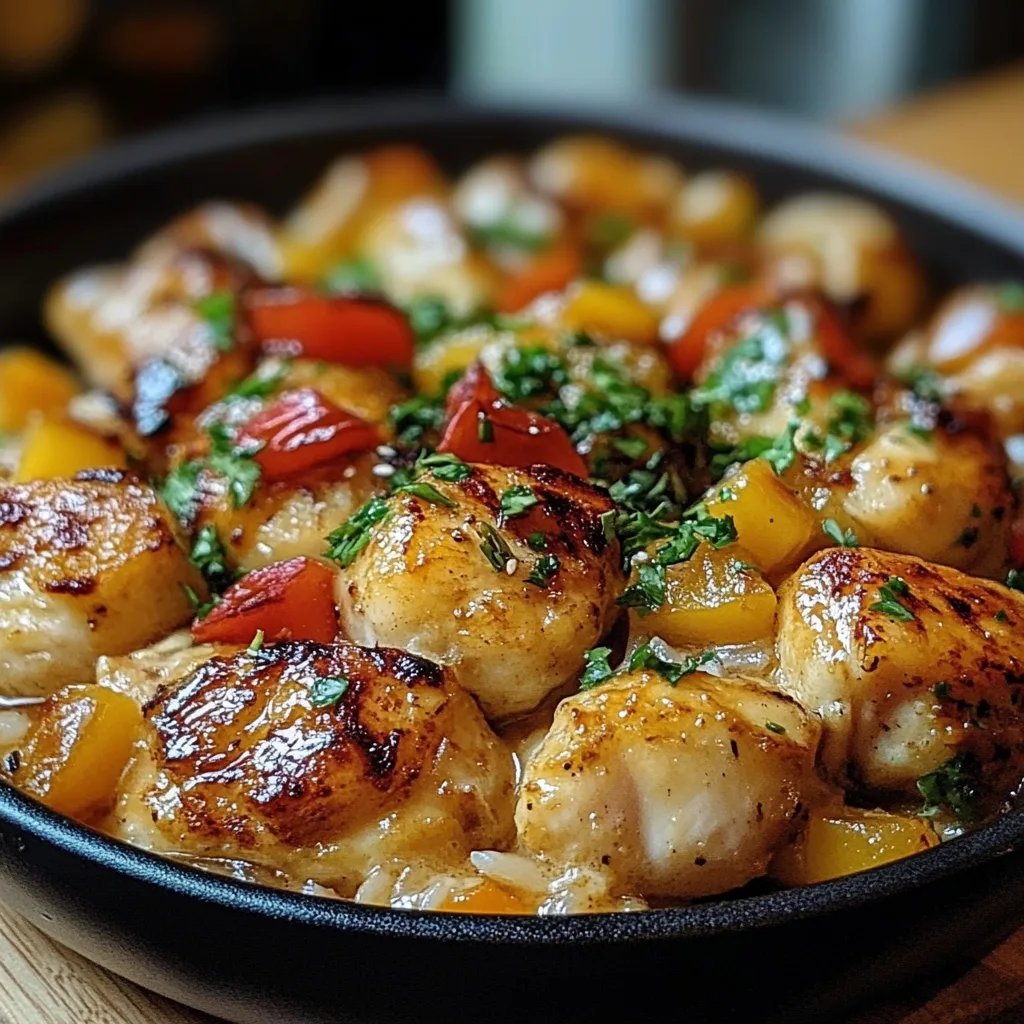Persian Chicken: An Amazing Ultimate Recipe You'll Love

Persian Chicken is a culinary gem that showcases the rich flavors and aromas of Persian cuisine. This dish incorporates tender chicken marinated in a medley of spices, herbs, and natural sweetness from fruits. Each bite unfolds a delightful experience that transports your taste buds to a world of exotic flavors. It’s an amazing dish for family gatherings, special occasions, or even just a cozy weeknight dinner.
If you’ve never tried Persian Chicken, you are in for a treat. The combination of spices, including saffron, cinnamon, and turmeric, elevates the dish to something extraordinary. Coupled with the addition of fresh herbs and fruits, it presents a colorful and aromatic feast that is sure to impress. This recipe isn’t just another chicken dinner; it’s a delightful highlight that can bring joy and comfort to your home.
In this article, we will guide you through the wonderful world of Persian Chicken, sharing its secrets while providing easy-to-follow instructions. You’ll learn why this dish is so loved, what you need to create it, and tips for serving it with elegance. Let’s dive into the captivating realm of Persian Chicken!
Why You'll Love This Recipe
When it comes to Persian Chicken, there are several reasons why this dish will steal your heart. Here are some enticing aspects that make it an incredible meal for any occasion:
- Rich Flavor Profile – The infusion of spices creates a depth of flavor that is truly satisfying.
- Colorful Presentation – The vibrant colors from herbs and fruits make the dish visually appealing.
- Ease of Preparation – Despite its rich flavors, this dish is simple to prepare and perfect for cooks of all skill levels.
- Healthy Ingredients – Combining chicken with fresh herbs and fruits ensures a healthy and balanced meal.
- Cultural Experience – Cooking and sharing this dish can bring a taste of Persian culture into your home.
- Adaptable Recipe – The recipe can be adjusted for various dietary needs, easily swapping chicken for other proteins if desired.
With these points in mind, it's easy to see why Persian Chicken has become a favorite in many households. The delightful harmony of time-tested ingredients offers an inviting conversation starter and makes it a remarkable dish.
Preparation and Cooking Time
Preparing Persian Chicken will take approximately 1 hour and 30 minutes, which includes marinating, cooking, and resting the dish. Here’s a breakdown of the time requirements:
- Preparation Time: 30 minutes (including marination)
- Cooking Time: 45-60 minutes
- Resting Time: 10-15 minutes
Be sure to consider these times when planning your meal, as they will provide a good framework for a delicious dining experience.
Ingredients
- 4 chicken thighs (bone-in, skin-on)
- 2 onions, finely sliced
- 4 cloves of garlic, minced
- 1 teaspoon ground cumin
- 1 teaspoon ground coriander
- 1 teaspoon turmeric
- 1 teaspoon saffron threads (soaked in 2 tablespoons of warm water)
- 1 teaspoon cinnamon
- 1 teaspoon black pepper
- 1 teaspoon salt
- ½ cup Greek yogurt
- 2 tablespoons olive oil
- 1 cup dried apricots, chopped
- 1 cup chicken broth
- Fresh herbs for garnish (parsley, cilantro, or mint)
- Lemon wedges, for serving
Step-by-Step Instructions
Creating Persian Chicken at home is easier than you may think! Follow these step-by-step instructions to achieve flavorful results:
- Marinate the Chicken: In a bowl, combine the yogurt, garlic, cumin, coriander, turmeric, saffron, cinnamon, black pepper, and salt. Coat the chicken thighs thoroughly in this mixture and let them marinate for at least 30 minutes (or up to overnight in the fridge for deeper flavor).
- Sauté the Onions: In a large skillet, heat the olive oil over medium heat. Add the sliced onions and sauté until they turn golden brown and soft, about 8-10 minutes.
- Brown the Chicken: Remove the chicken from the marinade, letting the excess drip off. Add the chicken thighs to the skillet, skin-side down, and brown them for about 5-7 minutes, then flip and brown the other side.
- Add the Liquid: Stir in the chopped dried apricots and pour in the chicken broth. Bring to a boil, then reduce to a simmer.
- Cook Thoroughly: Cover the skillet and let the chicken cook for 30-40 minutes, or until it’s fully cooked and reaches an internal temperature of 165°F (75°C).
- Final Touches: Once cooked, remove the skillet from heat. Allow the chicken to rest for about 10 minutes, then garnish with fresh herbs.
- Serve with Lemon Wedges: Present with lemon wedges on the side for a touch of brightness.
Following these instructions will guide you to an exceptional Persian Chicken that is packed with flavor and sure to impress your guests or family.
How to Serve
Enhancing the presentation of Persian Chicken can make dining even more enjoyable. Here are some serving tips to consider:
- Garnish Generously: Add freshly chopped herbs right before serving for a burst of color and flavor.
- Plating: Serve the chicken on a beautiful platter, drizzling the sauce over the top for an elegant touch.
- Accompaniments: Pair with fragrant rice, such as saffron basmati, or a fresh salad to balance the rich flavors of the chicken.
- Beverage Pairing: A light white wine or mint tea complements the aromatic spices beautifully.
- Family-Style Serving: Consider serving the chicken in a communal fashion, allowing guests to help themselves, which encourages interaction.
By making thoughtful choices in how you serve Persian Chicken, you'll transform a simple meal into a memorable dining experience filled with rich flavors and warm conversations. Enjoy your culinary journey!
Additional Tips
- Use Fresh Ingredients: Fresh herbs and quality spices will enhance the flavor of your Persian Chicken. Always opt for the freshest possible produce.
- Marinating Time: For the best results, consider marinating the chicken overnight. This allows the flavors to penetrate deeper into the meat.
- Adjust Spices to Your Taste: Feel free to modify the spice levels according to your preference. If you love heat, consider adding a pinch of cayenne pepper.
- Experiment with Fruits: While dried apricots are traditional, try adding raisins or prunes for an alternative sweetness that can complement the spices.
- Pair with Persian Rice: Serving your Persian Chicken with saffron basmati rice or jeweled rice can elevate the dish, providing a beautiful and flavorful accompaniment.
Recipe Variation
Trying different twists on the classic Persian Chicken can be fun! Here are some variations to consider:
- Vegetarian Alternative: Substitute the chicken with hearty vegetables such as eggplant or mushrooms, marinated in the same flavorful sauce.
- Pomegranate Twist: Add pomegranate seeds for a burst of color and sweetness. Their tartness pairs beautifully with the spices.
- Grill It: For a smoky flavor, marinate the chicken and then grill it instead of cooking it on the stovetop.
- Coconut Addition: Stir in some coconut milk for a creamier sauce, which adds a delightful tropical flavor.
- Herb Variations: Experiment with different herbs like dill or tarragon to give your Persian Chicken a unique flavor twist.
Freezing and Storage
- Storage: Store any leftovers in an airtight container in the refrigerator. This dish will stay fresh for about 4-5 days.
- Freezing: You can freeze Persian Chicken for up to 3 months. Make sure to portion it into individual servings and wrap it tightly to prevent freezer burn. Thaw in the refrigerator overnight before reheating.
Special Equipment
While making Persian Chicken is quite accessible, having a few tools can enhance your experience:
- Large Skillet: A good-quality skillet helps brown the chicken evenly and allows for effective sautéing.
- Mixing Bowls: Use bowls for marinating and mixing, ensuring you have enough space to combine your ingredients.
- Meat Thermometer: This ensures that your chicken is fully cooked and safe to eat, providing precision in cooking.
- Sharp Knife: A sharp knife will ease the chopping of herbs and fruits, ensuring precision and safety in your preparation.
- Wooden Spoon: Great for stirring and serving, giving you control over the cooking process.
Frequently Asked Questions
What is the best chicken cut to use for Persian Chicken?
Chicken thighs are recommended because they remain juicy and tender during cooking. However, boneless breasts can also work.
Can I use fresh herbs instead of dried ones?
Yes! Fresh herbs generally provide a brighter flavor. Use about three times the amount of fresh herbs as dried.
Is Persian Chicken spicy?
This dish is typically not spicy but has layers of warm spices. You can adjust the heat by adding peppers if desired.
Can I make Persian Chicken ahead of time?
Absolutely! It can be prepared in advance, stored in the refrigerator, and reheated. The flavors often develop further after sitting.
What sides pair well with Persian Chicken?
Popular sides include saffron basmati rice, roasted vegetables, or a simple cucumber-tomato salad.
Conclusion
Persian Chicken is more than a meal; it is a flavorful journey into the heart of Persian cuisine. With its rich flavors, vibrant colors, and simplicity of preparation, it is a dish sure to impress any guest. Whether you’re hosting a gathering or enjoying a quiet dinner at home, this recipe will bring the exotic tastes of another culture right to your table. Embrace the beauty of Persian dining and savor the joy this delightful chicken dish brings!
